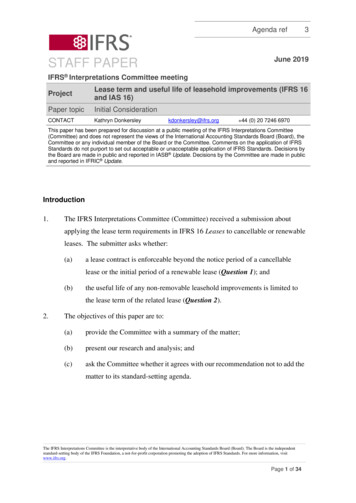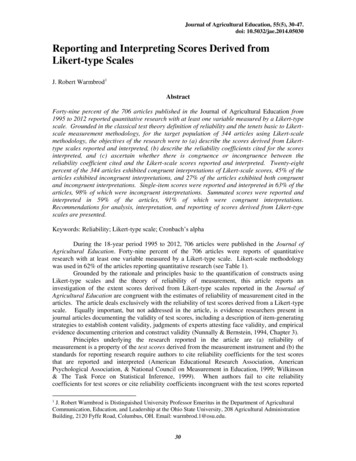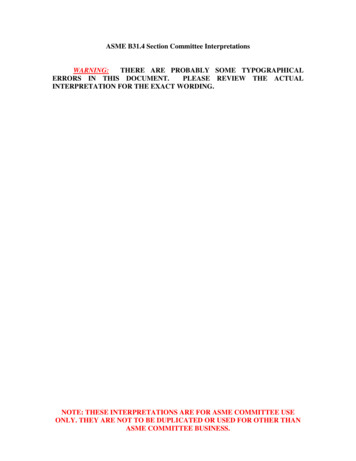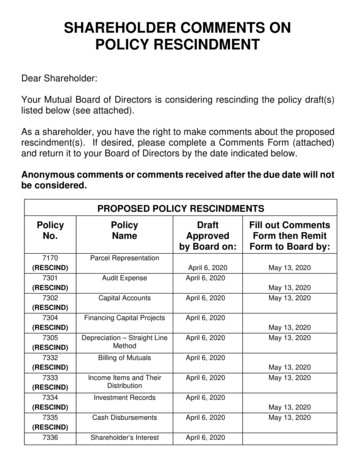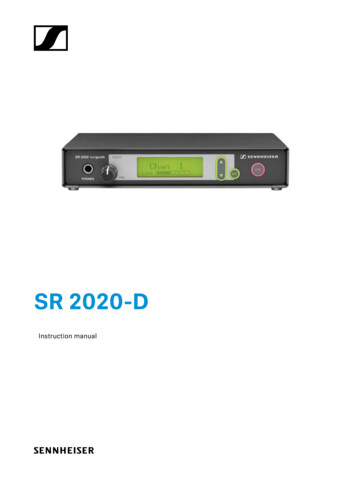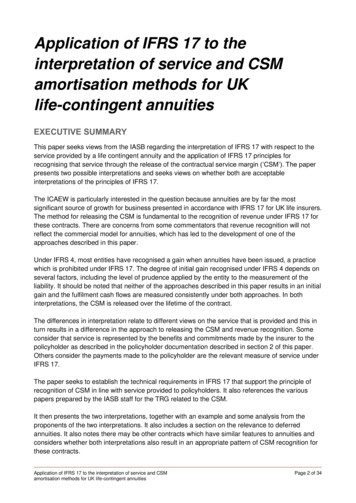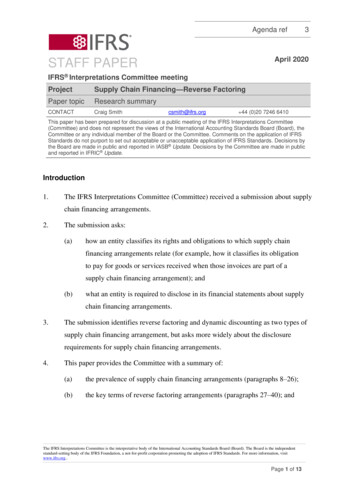
Transcription
Agenda ref3April 2020STAFF PAPERIFRS Interpretations Committee meetingProjectSupply Chain Financing—Reverse FactoringPaper topicResearch summaryCONTACTCraig Smithcsmith@ifrs.org 44 (0)20 7246 6410This paper has been prepared for discussion at a public meeting of the IFRS Interpretations Committee(Committee) and does not represent the views of the International Accounting Standards Board (Board), theCommittee or any individual member of the Board or the Committee. Comments on the application of IFRSStandards do not purport to set out acceptable or unacceptable application of IFRS Standards. Decisions bythe Board are made in public and reported in IASB Update. Decisions by the Committee are made in publicand reported in IFRIC Update.Introduction1.The IFRS Interpretations Committee (Committee) received a submission about supplychain financing arrangements.2.The submission asks:(a)how an entity classifies its rights and obligations to which supply chainfinancing arrangements relate (for example, how it classifies its obligationto pay for goods or services received when those invoices are part of asupply chain financing arrangement); and(b)what an entity is required to disclose in its financial statements about supplychain financing arrangements.3.The submission identifies reverse factoring and dynamic discounting as two types ofsupply chain financing arrangement, but asks more widely about the disclosurerequirements for supply chain financing arrangements.4.This paper provides the Committee with a summary of:(a)the prevalence of supply chain financing arrangements (paragraphs 8–26);(b)the key terms of reverse factoring arrangements (paragraphs 27–40); andThe IFRS Interpretations Committee is the interpretative body of the International Accounting Standards Board (Board). The Board is the independentstandard-setting body of the IFRS Foundation, a not-for-profit corporation promoting the adoption of IFRS Standards. For more information, visitwww.ifrs.org.Page 1 of 13
Agenda ref(c)3how entities account for reverse factoring arrangements (paragraphs 41–51).5.Appendix A reproduces the submission.6.This paper does not ask the Committee to make any decisions—it provides onlybackground information about supply chain financing arrangements that we haveobtained from our research and outreach. We thought it would be helpful forCommittee members to become familiar with such arrangements at the April 2020meeting.7.We then plan to bring a paper to the June 2020 Committee meeting that includes (a)staff analysis of the application of IFRS Standards to such arrangements; and (b) staffrecommendations for the Committee’s consideration.How common are supply chain financing arrangements?8.We sent information requests to members of the International Forum of AccountingStandard-Setters, securities regulators, and large accounting firms. The submissionwas also made available on our website.9.The request asked those participating to provide information about whether, based ontheir experience, supply chain financing arrangements are common. If so, we askedrespondents to provide information about the most common types of supply chainfinancing arrangement. We also asked those participating to provide informationabout how entities account for supply chain financing arrangements.10.We received 13 responses—seven from national standard-setters, four from largeaccounting firms and two from organisations representing a group of securitiesregulators. The views received represent informal opinions and do not reflect theofficial views of those respondents or their organisations.Supply Chain Financing—Reverse Factoring Research summaryPage 2 of 13
Agenda ref3What are the common types of supply chain financing arrangement?11.A few respondents view supply chain financing arrangements as encompassing anumber of different arrangements. However, most respondents use ‘supply chainfinancing’ to mean ‘reverse factoring’.12.Those respondents who view supply chain financing arrangements broadly identifythree types of arrangement:(a)Reverse factoring—an arrangement involving three parties: an entity thatpurchases a good or service, a supplier providing those goods or servicesand a financial institution. The arrangement typically allows the supplier tobe paid by the financial institution at a date earlier than the entity pays thefinancial institution.(b)Dynamic discounting—an arrangement between an entity purchasing goodsand a supplier. The supplier offers a range of discounts that vary dependingon when the entity settles its payable to the supplier. The discount is oftendesigned to be highest on the date when the supplier would most like to bepaid, with lower discounts for payment further from that date.(c)Supplier inventory financing—a financial institution intermediarypurchases an item of inventory from the supplier and sells it to the entity.This may enable the entity to obtain longer credit terms for the purchase ofinventory than it would obtain if it were to receive the inventory directlyfrom the supplier.13.One respondent notes a transaction that produces a similar outcome to reversefactoring, but is not commonly considered supply chain financing. It is aware ofentities that pay suppliers using a bill of exchange (or letter of credit). The supplier isable to present the bill of exchange (or letter of credit) to the entity’s financialinstitution to obtain payment, which can be made early for a discount. The entity paysthe financial institution at the agreed expiry of the bill of exchange (or letter of credit).Supply Chain Financing—Reverse Factoring Research summaryPage 3 of 13
Agenda ref14.3Respondents that mention dynamic discounting say it is not common. In addition,only a few respondents mention supplier inventory financing, noting that it is commonmainly for commodity purchases1.How common are supply chain financing arrangements in particularjurisdictions?15.Respondents say reverse factoring arrangements are:(a)common in Australia, Brazil, China, Malaysia, Singapore, South Africa andSouth Korea; and(b)16.not common in Japan.A few respondents say reverse factoring arrangements are not common in Canada,Europe and Hong Kong, but their use is increasing. However, others say sucharrangements are common in Belgium, Canada, Denmark, France, Germany, HongKong, the Netherlands, Spain, Switzerland and the UK.Staff research17.We used the financial search engine, AlphaSense, to search for disclosure of supplychain financing arrangements in entities’ most recent interim or annual financialstatements. The search was limited to financial statements in English. We searched for‘supply chain financing’ broadly, as well as the arrangements described in paragraph12 of this paper.18.Our search identified a total of 219 entities disclosing supply chain financingarrangements in their financial statements:(a)145 entities disclose entering into supply chain financing arrangements;(b)14 suppliers disclose the receipt of funds in reverse factoring arrangements;and1The Board will discuss supplier inventory financing as part of its consideration of commodity-relatedtransactions at its April 2020 meeting.Supply Chain Financing—Reverse Factoring Research summaryPage 4 of 13
Agenda ref(c)360 financial institutions offer supply chain financing arrangements tocustomers.Entities entering into supply chain financing arrangements19.Most entities disclosing that they enter into supply chain financing arrangements referspecifically to reverse factoring arrangements.20.Some entities disclose that they enter into supply chain financing arrangements, butwe were unable to identify the type or term of those arrangements. It is possible that,similar to outreach respondents, some entities in our search use ‘supply chainfinancing’ to mean ‘reverse factoring’. No entities disclose entering into dynamicdiscounting or supplier inventory financing arrangements.21.Entities disclosing supply chain financing arrangements are based in 34 jurisdictions.In our analysis, entities disclosing supply chain financing arrangements are mostcommonly based in France, Poland, Spain and the UK.Financial institutions22.The financial institutions in our search are also based in many jurisdictions. Many ofthe entities we identified say they offer supply chain financing arrangements in China.23.In addition, financial institutions in jurisdictions in the Middle East, South Asia andSoutheast Asia say they have begun offering supply chain financing arrangements tocustomers over the past year. This indicates that, in those jurisdictions, supply chainfinancing arrangements may not be common at present but could become so in thefuture.Supply Chain Financing—Reverse Factoring Research summaryPage 5 of 13
Agenda ref3Other evidence24.We have also reviewed some publicly available reports on reverse factoring:(a)The PwC SCF barometer 2018/20192 indicates that around 50% ofrespondents to a survey already have a reverse factoring agreement in place,with a further 40% considering doing so.(b)A Fitch report published in July 20183 estimates that there has been anincrease in payables being factored of USD 327bn since 2014. It also says itis often difficult to identify from an entity’s financial statements whether ithas entered into a reverse factoring arrangement.Staff conclusion25.The submission identifies several types of supply chain financing arrangement. Theinformation obtained from outreach and our own research (see paragraphs 11–24above) indicates that the most common type of arrangement is reverse factoring.Indeed, many respondents use ‘supply chain financing’ to mean ‘reverse factoring’.We have also spoken to the submitter and we understand the focus of their question ison reverse factoring arrangements.26.Accordingly, for the remainder of this paper we discuss only reverse factoringarrangements.How do reverse factoring arrangements work in practice?27.As noted above, reverse factoring arrangements involve (a) a financial institutionpaying an entity’s suppliers amounts owed by the entity, and (b) the entity paying thefinancial institution. We understand reverse factoring arrangements are often set up bylarge corporates with good credit ratings. Reverse factoring arrangements inance27-07-2018Supply Chain Financing—Reverse Factoring Research summaryPage 6 of 13
Agenda ref3facilitate an entity’s suppliers using the entity’s credit rating to obtain financing at acost lower than the supplier would be able to obtain itself.28.The terms of reverse factoring arrangements vary depending on the agreement betweenthe entity, its suppliers and the financial institution. We have identified two broad typesof reverse factoring arrangement—those primarily set up to enable:(a)an entity’s suppliers to receive payment for their trade receivables beforethe due date (paragraphs 34–38); and(b)29.an entity to settle trade payables later than the due date (paragraphs 39–40).Although we have identified two broad types, we note that a reverse factoringarrangement may benefit both the entity and its suppliers. For example, even though areverse factoring arrangement may be set up to enable an entity to settle tradepayables later than their due date, that arrangement may also enable suppliers toaccess payment for those balances before the due date.30.In both types of reverse factoring arrangement, information is typically exchangedbetween the parties to the arrangement through the use of a ‘platform’ offered by thefinancial institution to the entity. When an entity receives an invoice from a supplierand is satisfied with the goods or services received, the entity uploads the invoiceinformation to the platform. This may be in conjunction with an irrevocable paymentundertaking, which confirms the entity’s intention to pay the invoice.31.Platforms can be used by an entity to manage their trade payables. An entity mayupload information about all its trade payables (including invoices from suppliers notparticipating in the reverse factoring arrangement). If an entity’s suppliers participatein a reverse factoring arrangement, the invoice’s inclusion on the platform informs thefinancial institution that the amount could potentially be factored.32.In some reverse factoring arrangements, the financial institution may also act as theentity’s paying agent. In that case, the financial institution:(a)assumes responsibility for paying suppliers participating in the reversefactoring arrangement; andSupply Chain Financing—Reverse Factoring Research summaryPage 7 of 13
Agenda ref(b)3has permission from the entity to pay itself using amounts from the entity’sbank account on the invoice due date.33.Respondents say, in a few jurisdictions, the reverse factoring arrangements enteredinto legally novate the trade payable so that, on inclusion of an invoice in thearrangement, the payable is owed to the financial institution (rather than the supplier).Arrangements enabling a supplier to receive payment earlier34.Respondents say reverse factoring arrangements are most commonly set up to enablean entity’s suppliers to receive payment for invoices earlier than the date on whichpayment is due.35.Arrangements of this type:(a)often require little input from the entity, other than to approve the invoicesfor payment by their inclusion on the platform. Once an invoice is uploadedto the platform, the financial institution may offer early payment to thesupplier, or take advantage of early settlement discount the supplier hasoffered to the entity in the invoice.(b)may offer the supplier the option of factoring the entity’s payables on aninvoice-by-invoice basis. In this case, the entity may be unaware of whetherits payable for a particular invoice has been paid by the financial institutionbefore the date it would otherwise be due.36.In its simplest form, reverse factoring arrangements of this type do not extend thecredit terms available to the entity from those agreed with the supplier, and typicallydo not change the other terms of the liability. The only change resulting from thearrangement is that the entity pays the financial institution, rather than the supplier, onthe date the invoice is due.37.However, respondents also note that in many cases an entity and its suppliers agree toextended credit terms—that apply to all invoices—at the same time as the entity setsup the reverse factoring arrangement. The entity may have been unable to obtain theextended credit terms if the arrangement were not put in place.Supply Chain Financing—Reverse Factoring Research summaryPage 8 of 13
Agenda ref38.3By entering into a reverse factoring arrangement, the financial institution takes oncredit risk associated with the entity’s non-payment of the trade payable. Somerespondents say financial institutions sometimes seek additional credit enhancementsfrom the entity. For example, to enter into a reverse factoring arrangement, somefinancial institutions may require a guarantee from the entity’s parent company oranother group company.Arrangements enabling an entity to settle payments later39.Respondents say in some cases an entity enters into a reverse factoring arrangement toenable settlement of trade payables later than it would under the credit terms agreedbetween the entity and its suppliers.40.In such an arrangement, the financial institution typically pays the supplier no laterthan the date the trade payable was due under the agreement between the entity andthe supplier. However, separately the entity and the financial institution agree a laterpayment date by which the entity is required to pay the financial institution. Thelength of any extension of credit terms depends on negotiations between the entity andthe financial institution.How do entities account for reverse factoring arrangements?41.Outreach respondents say entities account for reverse factoring arrangementsdifferently; many note that this may reflect the differing terms of each arrangement.42.Respondents provided information about how an entity accounts for reverse factoringarrangements in:(a)its statement of financial position (paragraphs 43–48);(b)its statement of cash flows (paragraphs 49–50); and(c)its disclosures (paragraph 51).Supply Chain Financing—Reverse Factoring Research summaryPage 9 of 13
Agenda ref3Statement of financial position43.Respondents say an entity entering into a reverse factoring arrangement first considersthe requirements for derecognition of financial liabilities in paragraphs 3.3.1–3.3.2 ofIFRS 9 Financial Instruments. Those paragraphs require an entity to derecognise afinancial liability (or a part of it) when:(a)the liability is extinguished—that is, when the obligation specified in thecontract is discharged or cancelled or expires; or(b)there has been a substantial modification of the terms of the financialliability or a part of it.Arrangements enabling a supplier to receive payment earlier44.Respondents say, on entering into a reverse factoring arrangement, an entity typicallydoes not derecognise its trade payables when it receives no extension of credit terms.This is because, in that situation, entities often conclude that their obligation is notextinguished and there is no substantial modification of trade payables. As mentionedin paragraph 35(b) of this paper, the entity might be unaware of whether, and when,the financial institution has paid the supplier before the invoice’s due date.45.Entities consider a number of factors in determining whether there has been asubstantial modification of a trade payable. For example:(a)whether the nature of the liability has changed—the liability is to pay forgoods or services received from a supplier and often the nature of thatliability does not change;(b)whether the credit terms have changed—the entity is required to pay theamount of the invoice on the date it agreed to pay the supplier and, as notedabove, often the credit terms do not change.46.In some cases, entities derecognise trade payables and, instead, recognise otherfinancial liabilities. Respondents say this is common when the reverse factoringarrangement legally novates the payable to the financial institution.47.Some respondents note that reverse factoring arrangements are often designed toensure the entity can continue to report the liability as a trade payable.Supply Chain Financing—Reverse Factoring Research summaryPage 10 of 13
Agenda ref3Arrangements enabling an entity to settle payments later48.Respondents say entities typically—but do not always—reclassify trade payables asother financial liabilities when a reverse factoring arrangement allows the entity topay its liability later than the invoice due date.Statement of cash flows49.Respondents say the classification of cash outflows on settlement of the liabilitytypically follows the classification of the liability in the statement of financialposition—ie:(a)if an entity classifies its liability as a trade payable, it typically classifies thecash outflow on settlement of that liability as an operating cash flow.(b)if the entity classifies the liability as other financial liabilities, it typicallyclassifies the cash outflow as a financing cash flow.50.If an entity classifies the cash outflow as a financing cash flow, it will report loweroperating cash outflows than an entity not using a reverse factoring arrangement. Thiscan make it difficult for users of the entity’s financial statements to determine the cashflow effect of purchasing goods and services in the ordinary course of business.Respondents say entities classifying the cash outflow from settling the liability as afinancing cash flow typically either:(a)disclose a non-cash transaction at the time of entering into the reversefactoring arrangement applying paragraph 43 of IAS 7 Statement of CashFlows; or(b)‘gross up’ the cash flows in the reverse factoring arrangement. In otherwords, the entity presents (i) a cash outflow from operating activities and acash inflow from financing activities when the invoice is factored by thefinancial institution; and (ii) a cash outflow from financing activities whenthe entity settles the liability.Supply Chain Financing—Reverse Factoring Research summaryPage 11 of 13
Agenda ref3Disclosure51.Respondents say entities often do not disclose the existence of reverse factoringarrangements. Entities presenting amounts owed under reverse factoring arrangementsas other financial liabilities disclose information more frequently than thosepresenting amounts owed as trade payables. Some respondents say those entitiesdisclosing information about reverse factoring arrangements often do so as a result ofdisclosure requirements (for example, those about liquidity risk) in IFRS 7 FinancialInstruments: Disclosures.Question for the CommitteeDoes the Committee have any questions or comments on the information provided inthis paper?Supply Chain Financing—Reverse Factoring Research summaryPage 12 of 13
Agenda ref3Appendix A—submissionA1. We have reproduced the submission below:Supply Chain Financing—Reverse Factoring Research summaryPage 13 of 13
31 January 2020IFRS Interpretations CommitteeIFRS FoundationColumbus Building7 Westferry CircusLondon E14 4HDBy Electronic Mail: ifric@ifrs.orgDear Members of the IFRS Interpretations Committee,CLASSIFICATION AND DISCLOSURE OF LIABILITIES AND LIQUIDITY RISKSARISING FROM SUPPLY CHAIN FINANCING ARRANGEMENTSMoody’s Investors Service (MIS) appreciates the opportunity to provide the InternationalFinancial Reporting Standards Interpretations Committee (the Interpretations Committee) withour observations on current practices in the classification and disclosure of liabilities andliquidity risks arising from supply chain financing (SCF) arrangements such as reverse factoring(RF). In our experience, the use of SCF arrangements, including RF, is widespread, butdisclosure of the practice is not. In fact, as highlighted in recent MIS research,1 fewer than 5% ofthe entities rated by MIS are actually disclosing usage together with the impact on their financialstatements and risk profile.2 This raises three concerns: First, without adequate disclosure it is difficult for users of financial statements tocompare companies using SCF with those that do not. SCF itself takes many forms,and the consequences of RF may be different to other tools such as dynamic discounting.Disclosure of the nature of these liabilities is important to ensure all users of financialstatements can transparently and consistently assess the nature of the company’saggregate debt-like liabilities. Second, SCF arrangements obscure the nature of debt-like liabilities. The purpose ofSCF products, including RF, is deliberately to distort the natural working capitalequilibrium between supplier and customer because it enables earlier payment to thesupplier and later payment by the customer. The funding gap is bridged by a bank or1“Non-financial companies – Global: Reverse factoring is increasingly popular but can weaken liquidity at atime of stress,” Moody’s Investors Service,19 September 2019.2“SCF Barometer 2018/2019,” PwC & Supply Chain Finance Community.
2other funding provider. We are aware that some RF-providing banks will add together RFfacilities with conventional debt facilities to calculate aggregate corporate exposurelimits. Without consistent disclosure, stakeholders such as credit rating agencies cannoteffectively evaluate aggregate leverage, and bondholders could potentially be frustratedin their ability to set and manage debt covenants effectively and consistently. Third, default risk is obfuscated without adequate disclosure. The lack of disclosureblurs the important distinction between operating and financing cashflows, and the risk ofRF facilities falling away can materially increase default risk.MIS requests that the Interpretations Committee consider providing guidance on:1. Disclosure – the appropriate disclosure in the financial statements of a company whenSCF arrangements are used; and2. Classification – whether the process of overlaying an irrevocable payment undertakingover a simple trade invoice has the effect of transforming that invoice into a differentobligation that should be disclosed separately from trade payables.In the attached Annexes, we address these concerns in further detail (Annex I) and providereasons for the Interpretations Committee to address the issue (Annex II).We trust that the information provided in our letter is clear but please do not hesitate to contactus should you wish to discuss the submission or any aspect of it in further detail.Yours faithfully,/S/ Philip RobinsonPhilip RobinsonVice President – Senior Credit OfficerCorporate Finance
3ANNEX II.BackgroundFor every sector and company there is a natural equilibrium to working capital, though thatequilibrium is not the same for every sector or company. It can fluctuate as a function offinancial policy, credit quality and other factors. However, many forms of SCF distort the naturalworking capital equilibrium by introducing a gap between the point at which payment is made tothe supplier versus the later point at which payment is made by the customer. This gap is bridgedby financing, and such financing should be accurately disclosed so that it is transparent to allusers of a company’s financial statements.There are multiple perspectives from which such improved disclosure is required: Leverage, coverage and covenants. Many stakeholders use company financialstatements to assess debt leverage or coverage levels. Different stakeholders may chooseto take a wider or narrower definition of leverage, including or excluding elements suchas lease financing alongside pure financial debt obligations. Different stakeholders mayvalidly prefer different definitions to suit their varying requirements and comprehensivedisclosure by the company would allow them to make an informed and accurateassessment. At present there is a risk that debt leverage and coverage covenants designedto measure and limit aggregate indebtedness may be frustrated by the lack of disclosureand potential omission of SCF liabilities. Different types of SCF. SCF is an umbrella label for a range of financing techniques,including RF and dynamic discounting. Improved disclosure about the use of differentSCF tools would allow stakeholders to assess their differentiated impacts and risks, andwhether the product is being used to extend payment terms beyond those that the supplierwould accept in the absence of the facility. Asymmetric disclosure. At present if SCF usage and obligations are not disclosed, itappears that banks and other funding providers who provide SCF facilities, while at thesame time participating in a company’s core financing facilities, are better sighted on thecompany’s aggregate funding requirements than other debt creditors such as bondholderswho may primarily rely on reported information. Such a situation may favour SCFproviders and allow such banks quickly to reduce exposure to the company if stress startsto crystallise, while other creditors may be disadvantaged. That asymmetric disclosurecreates scope for unexpectedly asymmetrical losses for bondholders. While it mayeconomically favour the bank in the short term, there is scope for broader reputationaldamage to the bank as well to the extent they knowingly leveraged asymmetricalinformation to their advantage. Both these issues could be mitigated throughcomprehensive disclosure in advance. Impact of irrevocable payment undertakings (IPUs). We are aware that in some cases,before advancing early payment to a supplier, SCF providers may require that the
4customer provides an IPU in respect of the underlying invoice. By design that transformsa trade payable obligation – which might normally be disputed on the grounds of nondelivery or quality of goods and services provided, and has no absolute specific paymentdate – into a more certain and readily ‘monetisable’ asset whereby the right to challengeis waived and payment is undertaken to be made at a specific date. The benefits to theSCF provider are clear in that payment by the customer is now more certain than for anormal trade payable. We seek clarity on whether the process of overlaying an IPU ontop of a simple trade invoice has the effect of transforming that invoice into a differentobligation that should be disclosed separately from trade payables. Consistency. Specifically, we do not assert that SCF is ‘a bad product’ or that companiesthat use it should in some way be penalised. However, in rank ordering the credit qualityof around 5,500 rated non-financial corporates, it is a challenge if disclosure isinconsistent. Consistent and transparent disclosure would aid our objective to accuratelyrank companies based on their credit quality. The chart below illustrates the evolution inthe accounts payable days metric over the last three years for three companies in EMEA.The metrics all show a similar pattern, i.e. a multi-year trend at a consistent levelfollowed by a marked increase, especially in the last two to three years. Company Adiscloses use of RF and the actual amount; Company B discloses use of SCF but not theamount; Company C does not explain the increase in its financial statements. To reiterate,we make no criticism of Company A or Company B for using SCF, nor of Company Cfor not disclosing (and without disclosure, we cannot reliably tell whether the rise isattributable to SCF or some other reason).Company A (uses and discloses amount)Company B (uses but doesn't disclose amount)Company C (no relevant disclosure)110Accounts payable 2012201320142015201620172018In our September 2019 report “Non-finan
supply chain financing arrangement, but asks more widely about the disclosure requirements for supply chain financing arrangements. 4. This paper provides the Committee with a summary of: (a) the prevalence of supply chain financing arrangements (paragraphs 8-26); (b) the key terms of reverse factoring arrangements (paragraphs 27-40); and
